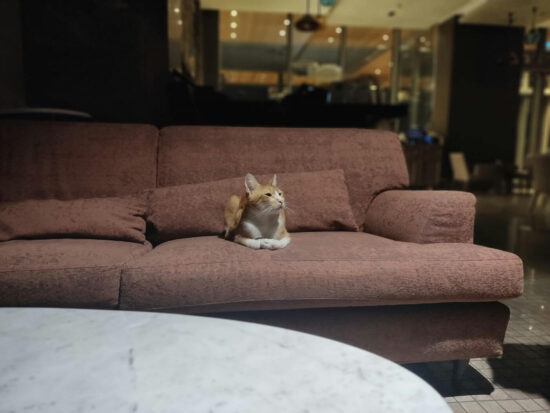Love your cat but hate what they’re doing to your couch? You’re not alone. Cats scratch and climb furniture because it’s natural behavior for them. They’re marking their territory, stretching their muscles, and keeping their claws healthy. The good news is that you can protect your furniture without hurting your furry friend.
Finding the right spray to keep cats off furniture means choosing safe, humane methods that work with your cat’s instincts instead of against them. Cat experts recommend using the gentlest approach possible. Most cats learn to avoid areas after just three experiences with a deterrent.
This guide covers some different sprays, from simple homemade recipes to commercial products. Some work by scent, others use special cat pheromones. The key is finding what works for your specific cat and situation.
1. Vinegar and Dish Soap Spray
This simple homemade spray is one of the most popular solutions among cat owners. Mix equal parts white vinegar (or apple cider vinegar), liquid dish soap, and water in a spray bottle. The strong smell of vinegar naturally repels cats because they dislike acidic scents.
To use this spray, test it on a hidden area of your furniture first to make sure it won’t cause staining. Then spray it lightly on the areas where your cat likes to scratch or climb. The soap helps the mixture stick to surfaces and reduces the vinegar smell for humans.
This spray to keep cats off furniture works well because it’s cheap and uses ingredients most people already have at home. The downside is that the smell can be strong at first, and you might need to reapply it often. The good news is that it’s completely safe for cats and won’t damage most furniture materials.
2. Citrus Peel Spray
Cats naturally hate the smell of citrus fruits like lemons, oranges, and limes. To make this spray, boil citrus peels in water for about 15 minutes, let it cool, strain out the peels, and pour the liquid into a spray bottle.
This method works because citrus contains compounds that cats find overwhelming. You can spray it around your furniture or even scatter fresh citrus peels near problem areas. Many people like this option because it smells pleasant to humans and uses natural ingredients.
However, be careful with citrus sprays. While diluted versions are generally safe, citrus oils can be toxic to cats if they lick large amounts or get it on their skin. Never spray this directly on your cat, and watch for any signs of irritation like excessive drooling or skin redness.
3. Coffee Grounds Spray
Got leftover coffee? Don’t throw those grounds away. Steep used coffee grounds in water for a few hours, strain the liquid, and put it in a spray bottle. Cats dislike the bitter, strong smell of coffee, making this an effective deterrent.
This spray works well around the base of furniture and in corners where cats like to scratch. It’s a great way to recycle coffee waste and costs almost nothing to make. The coffee scent is usually mild enough that it won’t bother most people.
Keep in mind that coffee spray might stain light colored fabrics, so always test it first. Also, while coffee is generally safe for cats in small amounts, some cats might be sensitive to caffeine, so watch your pet’s behavior after using this method.
4. Essential Oil Spray (Use Very Carefully)
Some people make sprays using essential oils like eucalyptus and lemon. A typical recipe calls for 10 drops each of eucalyptus and lemon essential oil, a few drops of dish soap, and water to fill a spray bottle.
Important warning: Many essential oils are toxic to cats and can cause serious liver damage. Cats can’t process these oils the way humans do, and even small amounts can make them sick. If you choose to try this method, use it only in areas with good air flow, never spray it directly on surfaces your cat might lick, and stop using it immediately if your cat shows any signs of illness.
Signs of essential oil poisoning in cats include drooling, vomiting, difficulty breathing, or unusual behavior. Because of these serious risks, most veterinarians recommend avoiding essential oil sprays entirely when you have cats.
5. Pet MasterMind Claw Withdraw Spray
This commercial product is often considered the best spray to keep cats off furniture by many cat owners and experts. It contains water, a rosemary based herbal blend, and a paraben free preservative. The natural herbal scents work to keep cats away without using harsh chemicals.
To use this spray, apply it to problem areas 2 to 3 times daily during the first week, then gradually reduce how often you use it. Many cats start avoiding treated areas within just a few days, though it can take up to two weeks for some stubborn kitties.
This product costs more than homemade options, but many people find it worth the price because it’s specifically designed for furniture and is safe for both cats and humans. It can be used on couches, countertops, and even plants without causing damage.
6. Nature’s Miracle Advanced Platinum Cat Scratch Deterrent
Nature’s Miracle makes products specifically for pet problems, and their scratch deterrent spray is designed to stop destructive scratching behavior. This commercial spray uses a special blend of ingredients that cats naturally want to avoid.
The company recommends daily application and suggests testing the product on a small area first. Many cat owners report good results with this spray, especially when used consistently over several weeks.
Like most commercial products, this spray contains some chemical ingredients and has a stronger smell than natural alternatives. However, it’s formulated specifically for cat behavior and tends to last longer than homemade sprays.
7. Four Paws Keep Off Spray
This aerosol spray contains methyl nonyl ketone, which confuses cats’ sense of smell. Instead of spraying it directly on furniture, spray it on a towel and place the towel near the area you want to protect. This method helps avoid potential staining while still being effective.
The spray works quickly and covers large areas well because of its aerosol format. However, it has a strong chemical smell that many people find unpleasant. It also needs to be reapplied every 24 hours to stay effective.
Because this spray contains chemicals that could be harmful if cats ingest them, it’s best used for outdoor furniture or in areas where your cat won’t be able to lick the treated surfaces. Always use it in well ventilated areas.
8. Feliway Classic Spray
This unique product works differently than scent based deterrents. Feliway contains synthetic versions of the calming pheromones that mother cats naturally produce to comfort their kittens. Instead of making areas smell bad to cats, it helps reduce the stress and anxiety that often cause scratching behavior.
The spray is completely odorless and colorless, so it won’t affect your home’s smell or appearance. Studies show it reduces scratching and spraying behaviors in 90% of cats. Apply it once daily to problem areas.
While Feliway costs more than other options, many veterinarians recommend it because it addresses the root causes of unwanted behavior rather than just masking the problem. It’s especially helpful for cats who scratch because of stress or major changes in their environment.
9. Mighty Petz No Scratch Spray
Created by veterinarians, this natural spray contains organic rosemary, vanilla, and cinnamon extracts. These scents smell pleasant to humans but naturally repel cats. The formula contains no chemicals or alcohol, making it safe for both pets and furniture.
Apply this spray moderately to areas where your cat scratches, but always test a small area first. The natural ingredients make it safe to use throughout your home, and many people enjoy the mild, pleasant scent.
Results can vary between different cats, and some owners report that their particular cat wasn’t bothered by the scent. There have also been occasional complaints about leaky bottles, but overall reviews are positive for this best spray to keep cats off furniture.
10. Mouthwash Spray
This budget friendly option uses diluted mouthwash to keep cats away from furniture. Mix mint based mouthwash with water in a 1 to 3 ratio (one part mouthwash to three parts water). Cats generally dislike strong mint scents, making this an effective deterrent.
This spray to keep cats off furniture costs very little to make and ingredients are easy to find. The mint smell is usually pleasant or at least tolerable for humans. Simply mist it lightly around furniture legs and corners where cats like to scratch.
The main downside is that this spray might not be strong enough for cats who are determined scratchers. The effect also tends to wear off quickly, so you may need to reapply it frequently. Make sure the mouthwash you use doesn’t contain xylitol, which is toxic to pets.
How to Apply These Sprays Safely and Effectively
Getting Started
Before using any spray to keep cats off furniture, test it on a small, hidden area first. This helps you make sure it won’t stain or damage your furniture. Clean the furniture thoroughly and remove your cat from the room while you apply the spray.
Set up alternative scratching posts or cat trees before you start using deterrent sprays. Cats need to scratch, so giving them appropriate places to do it increases your chances of success.
Application Tips
Spray the deterrent evenly but don’t soak the fabric. Focus on edges, corners, and spots where your cat has scratched before. If you notice any staining, try spraying the product onto a cloth instead and placing it near the furniture.
Most sprays work best when applied every 24 to 48 hours at first. Once your cat starts avoiding the area, you can gradually reduce how often you use the spray. Be patient because most methods take 1 to 2 weeks of consistent use to work.
Safety First
Never spray these products directly on your cat. Make sure the room has good air flow when applying sprays, and watch for signs that your cat might be having a bad reaction. These could include difficulty breathing, skin irritation, or changes in behavior.
Keep all spray bottles stored safely where pets can’t reach them. If your cat shows any signs of illness after you start using a deterrent, stop using it right away and contact your veterinarian.
Other Ways to Protect Your Furniture
Physical Barriers
Some cat owners use double sided tape on furniture because cats hate the sticky feeling on their paws. Aluminum foil can also work as a deterrent. However, these methods can sometimes make cats more frustrated, which might lead to scratching in other places.
Plastic carpet runners placed upside down around furniture can create an uncomfortable surface that cats prefer to avoid. Furniture covers designed specifically for pet protection can also help while you’re training your cat to use appropriate scratching areas.
Positive Alternatives
The most important thing you can do is provide better options for your cat. High quality scratching posts, cat trees, and climbing structures give cats appropriate places to exercise their natural behaviors. Place these near the furniture you’re trying to protect.
Make the approved scratching areas more appealing by rubbing them with catnip or silvervine. Interactive toys can also help redirect your cat’s energy away from your furniture.
Environmental Changes
Motion activated spray devices can startle cats away from furniture without you being present. Rearranging your furniture to make it less accessible might also help. Providing elevated perches in other parts of the room gives cats high places to survey their territory without using your expensive sofa.
Regular nail trimming reduces the damage cats can do when they scratch inappropriate items. Most cats need their nails trimmed every 2 to 3 weeks.
What Not to Use
Dangerous Products
Never use tea tree oil, pine based cleaners, wintergreen, or concentrated peppermint products around cats. These can cause serious liver damage or other health problems. Any product containing phenols or benzyl alcohol should also be avoided.
Mothballs are sometimes suggested as cat deterrents, but they’re toxic if eaten and can cause serious poisoning. Stick to products specifically designed for use around pets.
Harmful Training Methods
Avoid punishment based training like yelling at your cat or spraying them with water. These methods increase stress and can make behavior problems worse. They can also damage the trust between you and your pet.
Declawing is never a good solution. It’s painful for cats and prevents them from defending themselves. Many veterinarians now refuse to perform this procedure because it’s considered inhumane.
Troubleshooting Common Problems
When Sprays Don’t Work
If your current spray isn’t working, try a different type. Some cats respond better to citrus scents while others are more bothered by herbal smells. You might also need to apply the spray more often at first or make sure you’re covering all the areas your cat targets.
Sometimes the underlying problem is stress or boredom rather than just scratching behavior. Consider whether there have been changes in your home that might be upsetting your cat.
Displaced Scratching
If your cat stops scratching one piece of furniture but starts scratching another, this is normal. Gradually treat all the furniture pieces while making sure your cat has plenty of appropriate scratching options available.
Strong Smells
If the spray smell bothers your family, try more diluted versions of homemade recipes. Pheromone based products like Feliway are completely odorless. You can also apply sprays when nobody’s home and let them air out before the family returns.
Final Thoughts
Protecting your furniture from cat damage takes patience and consistency, but it’s definitely possible. The best approach combines a good spray to keep cats off furniture with plenty of appropriate alternatives for your cat to use.
Remember that cats need to scratch and climb. These behaviors are natural and healthy, so the goal isn’t to stop them completely but to redirect them to appropriate places. Most cats respond well to gentle, positive training methods.
If you’ve tried multiple approaches and your cat’s behavior hasn’t improved after several weeks, consider talking to your veterinarian. Sometimes excessive scratching can be a sign of stress, anxiety, or even medical problems that need professional attention.
With the right combination of deterrents and alternatives, you can have both a happy cat and beautiful furniture. The key is finding what works for your specific situation and sticking with it long enough to see results.


